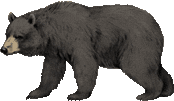|

Family Ursidae
Ursus americanus
Description: Black, brown, or blond hair; long, straight muzzle; slight shoulder hump but highest at the hips;
dark, strongly curved front claws less than 11/2 inches long; claw marks do not show in tracks. Male, 2 to 3 feet
high at the shoulder; 41/2 to 5 feet long; 180 to 400 pounds. Female, 120 to 180 pounds.
Similar species: Grizzly bear-larger; dished face; hump on shoulder.
Habitat/Distribution: Fairly common throughout the forested habitats of the region, black bears in habit dense
forests and riparian habitats throughout the year. They generally avoid clear-cuts until the brush and conifers
have grown back, except in spring, when they can often be seen on open slopes and in avalanche chutes, searching
for fresh green grasses.
Food: Omnivorous in their tastes, they eat grasses, sedges, berries, fruits, the inner bark of trees, insects,
honey, eggs, carrion, rodents, ungulates (both wild and domestic), and garbage.
Primarily nocturnal and usually solitary, black bears breed in June or July. After breeding, the females undergo
"delayed implantation" -a phenomenon in which the fertilized egg passes into the uterus but changes very
little until late fall, when it implants and then begins to grow rapidly. The young, from one to four but usually
two, are born naked and blind in the winter den and are fairly well developed before emerging in the spring.
The young stay with the mother until they are almost two years old. The female does not breed the summer after
the cubs are born. The cubs may den with her as yearlings. She breeds again the second summer after giving birth
and drives the almost-two-year-old cubs out before entering her winter den, where she win give birth to another
litter of cubs. The females first breed at either 2 ½ or 3 1/2 years.
Winter dens are often located in natural cavities found in trees or rocks, or under logs, brush piles, or buildings.
The bears line them with leaves, ferns, grasses or similar material. A black bear will occasionally dig a den for
itself, but it will be much less elaborate than that of its larger cousin, the grizzly bear.
|